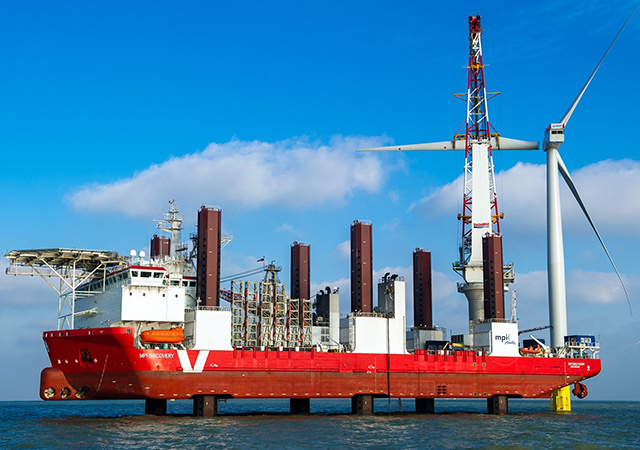
The robust offshore wind project pipeline, which became apparent between 2008 and 2010, saw many installation contractors place orders for new vessels, well aware that supply would be constrained otherwise.
Up to that point there had been a few pioneering vessels… mainly merchant vessel conversions, plus the ground-breaking, purpose-built Mayflower Resolution (now MPI Resolution).
This 14,000-ton dramatic scaling up of what is basically a Louisiana lift-boat in concept terms, was ordered in 2002 and built in China; the then owner also with an option to build a sistership.
Resolution set the mould. By the middle of 2011 there were almost a dozen wind turbine installation vessels under construction around the world.
Consequently, a large number of highly specialised vessels have come to market in recent times in expectation of future growth.
This phase of intense construction activity is coming to an end, and new vessel orders have slowed down with at least one major installation contractor stating that it has put a hold on its new-build plans due to potential oversupply in the future.
Despite these concerns, one installation contractor, Seajacks, has indicated that it is considering building a further two wind turbine installation vessels designed around the requirements of higher water depths and larger wind turbines.
The new fleet of self-propelled jack-up vessels has been designed for installation of both wind turbines and support structures with the very latest vessels capable of operating in water depths of 45m or more and having lifting capacities exceeding 800 tonnes.
Vessel design has been driven by the growing dimensions of modern offshore wind turbines.
For example, the weight of wind turbine nacelles is set to increase from around 100 tonnes in 2005 to more than 300 tonnes in five years time.
The ability to carry several very large wind turbines is also important due to the costs associated with transiting back and forth from installation ports to the windfarm site.
While the most recently completed vessels are similar in concept there does appear to be a smaller subset at the very high end of the market, which have been “future-proofed” to carry out installation of very large wind turbines… those of 7.5MW generating capacity and more.
These vessels include the HGO Innovation and Swire’s sister ships the Pacific Orca & Pacific Osprey. Project developers feel that it is these vessels that will be the most highly utilised as the market develops.
As well as increasing lifting and storage capacity project developers are also keen to identify means to widen the operating windows for installation.
Planting wind turbines at sea is particularly sensitive to weather conditions, and as a consequence has tended to be carried out in the calmer summer months.
However, it seems likely that installers will need to be able to operate into the winter months as the sector ramps up in scale. This demands larger vessels with superior sea-keeping qualities. In that regard, offshore wind is no different to offshore oil and gas where weather windows are also of critical importance.
Within the new-build supply chain, hull construction has been dominated by yards in Korea, China, and the Middle East due to a combination of lower labour costs and/or economies of scale.
In that regard, the Resolution’s first owner, Mayflower Energy, set a clear trend though, for example, the Aeolus is currently under construction in Germany.
At the same time, it is worth noting that many of the critical vessel sub-components such as cranes, propulsions systems and prime movers continue to be sourced from European suppliers.
Over Douglas-Westwood’s extended forecast period, project data indicates full-time demand for 16 specialist vessels to carry out wind turbine installation and 17 vessels to carry out support structure installation.
The D-W market modelling approach assumes year-round working and that vessels move seamlessly from one project to another so there is upside potential in the figures.
Despite there being potential oversupply in the market, it should be noted that the lower specification installation vessels are likely to migrate into the service market, which will expand greatly as the cumulative capacity increases.
Recommended for you
